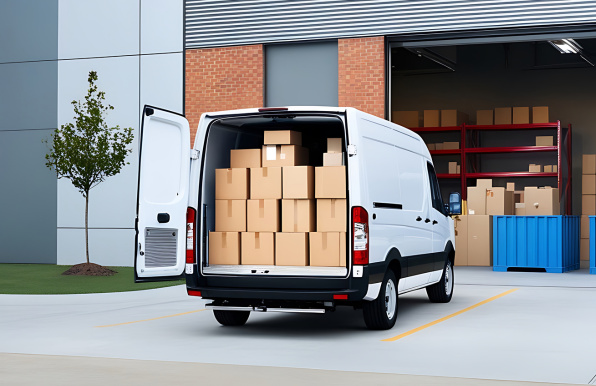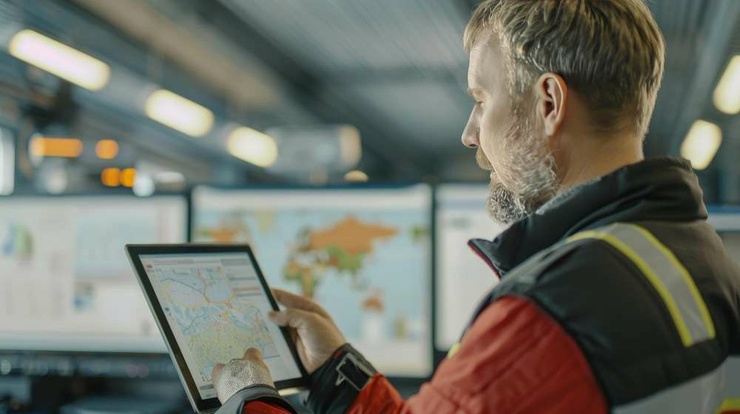- Last-Mile
How Electric Vehicles are the Game Changer for Last Mile Delivery Logistics
Table of Contents
- The Case for Electric Vehicles in Last Mile Delivery
- Tangible Benefits of EVs for Your Delivery Fleet
- Addressing EV Adoption Barriers
- Strategies for Seamless EV Integration
- Enabling Technologies and Strategic Partnerships
- Spotlight: Electric Fleet Pilot Successes
- Looking Ahead: Trends in Electric Last Mile Transport
- Enhance Your Last Mile Performance Using Electrification

With global e-commerce revenues expected to rise to $8.034 trillion by 2027, last mile delivery networks are under intense strain, and their environmental footprint is poised to grow. Studies suggest that, without a shift away from diesel fleets, carbon emissions from urban delivery traffic could surge by 60% by 2030.
Against this backdrop, electric vehicles in logistics offer a strategic imperative. By adopting electric vehicle logistics, operators leverage off-peak electricity rates to stabilize energy costs, eliminate complex engine maintenance, and deliver immediate Scope 1 emission reductions.
Quieter, zero-emission vans also open extended delivery windows in noise-restricted zones. The following discussion examines key drivers, benefits, and strategies for electrification adoption in urban delivery networks. Let us learn how each last mile electric vehicle can transform the total cost of ownership, bolster ESG performance, and unlock operational advantage.
The Case for Electric Vehicles in Last Mile Delivery
Growing urban density and strict sustainability timelines leave little room for diesel. Adopting electric vehicles in logistics simplifies compliance, cuts energy risk, and unlocks incentive programs, while delivering immediate Scope 1 emissions reductions and operational benefits for urban delivery fleets.
- Coping with Rising Fuel Costs and Total Cost of Ownership
Off-peak electricity contracts stabilize budgets, and a simplified drivetrain removes oil changes, belts, and exhaust treatment. Operators also gain predictable energy forecasting, which makes annual planning far easier than volatile diesel markets. These benefits are central to electric last mile vehicle programs and the broader economics of electrification.
- Hitting Sustainability and ESG Targets
Every last mile electric vehicle reduces Scope 1 emissions the instant it leaves the depot. This direct impact turns ESG pledges into audited proof, strengthening stakeholder confidence and easing upcoming disclosure rules.
- Taking Advantage of Incentives and Clean-Air Zones
Purchase rebates, accelerated depreciation, and zero-emission corridor access collectively shorten payback windows and shield fleets from rising congestion fees.
Tangible Benefits of EVs for Your Delivery Fleet
Battery adoption yields measurable wins beyond energy savings, turning sustainability from a cost center to a revenue lever. FarEye’s live dashboards translate those gains into KPIs that dispatchers can influence daily, keeping environmental goals visible on the operations floor.
- Lower Operating and Maintenance Outlays
Regenerative braking lengthens pad life, remote diagnostics predict cell wear, and the absence of engine oil keeps vans on the road longer. Lower downtime means planners can squeeze more stops into each shift without extra headcount.
- Cutting Carbon Emissions and Urban Noise
Zero tailpipe output cleans the air, and near-silent motors allow early-morning or late-evening windows impossible with diesel. Customers appreciate quiet curbside service, and city regulators grant extended delivery hours more readily.
- Strengthening Brand Image and Customer Loyalty
Shoppers increasingly choose merchants that share their environmental values. A branded EV at the curb reinforces a green promise at the exact moment of delivery, boosting repeat-purchase intent and social media mentions.
Addressing EV Adoption Barriers
Range anxiety, charging logistics, and upfront capital rank high on any EV rollout checklist. Solving each one systematically locks in advantages before scale-up. FarEye’s scenario engine lets planners test "what-if" cases, changing payload, stop count, and charger mix, so decisions rest on data rather than intuition.
- Overcoming Range Limits and Payload Trade-offs
Telematics data often shows that most urban loops sit comfortably inside a 120-mile battery envelope. For heavier furniture or appliance runs, route partitioning and mid-shift charging preserve payload and customer promises.
- Deploying Depot and On-route Charging Networks
A balanced mix of overnight AC plugs and strategic DC hubs prevents range stress without overinvesting in infrastructure. FarEye schedules charges only when required, aligning stops with planned driver breaks to protect productivity.
- Balancing Upfront Costs with Long-term Returns
Leasing, residual-value guarantees, and energy savings drop breakeven timelines below typical asset life. Finance teams can reallocate fuel budget to cover lease premiums, easing the shift to electric vehicle logistics.
Strategies for Seamless EV Integration
Data-driven rollouts generate returns from day one while limiting surprises. FarEye’s phased-deployment wizard groups routes by distance, terrain, and charger proximity, ensuring each new van enters service on exactly the right loop.
- Profiling Routes and Choosing the Right Vehicle Mix
Detailed stop-level analysis pairs compact vans with dense postal rounds and reserves larger e-trucks for pallet work, protecting range and payload margins alike.
- Crafting Efficient Charging Schedules
Smart load-balancing staggers plug-ins, captures low tariffs, and alerts dispatch if grid demand spikes, preventing costly power-draw penalties.
- Training Drivers and Crews on Electric Powertrains
Short classroom and ride-along sessions demystify torque curves and regen braking. Drivers quickly learn how to make small adjustments, gentler acceleration, coasting into stops, extending the range, and reducing maintenance.
Enabling Technologies and Strategic Partnerships
Digital ecosystems amplify electrification benefits and guard against service interruptions. Industry trend maps show that supply-chain visibility, IoT, and last mile innovation now dominate investment agendas, confirming that data integration is no longer optional.
- Telematics and Battery-Management Solutions
Cell-level sensors feed FarEye’s control tower, which can auto-reassign stops if a battery drifts below reserve, avoiding missed ETAs.
- Integrating with the Grid and Renewables
On-site solar arrays and demand-response contracts drive the carbon intensity of electric vehicles in logistics even lower while providing a hedge against daytime rate spikes.
- Partnering with Charging-station Networks
Public fast chargers complement depot hardware during seasonal peaks. FarEye’s routing engine checks live availability and dynamically updates schedules, keeping drivers informed and stress-free.
Spotlight: Electric Fleet Pilot Successes
Across industries, early adopters have already shown that well-planned electrification delivers rapid, measurable gains. The two examples below demonstrate how pairing FarEye’s data-driven platform with battery vehicles can convert climate ambition into operational advantage within a single peak season.
- How a Major Carrier Slashed Fuel Spend and Emissions
A global parcel leader recognized that fragmented data and limited visibility were undermining both cost control and climate reporting. Surface-level metrics masked the true carbon footprint of its third-party fleet and hub operations, leaving drivers and terminal teams without clear incentives to drive down emissions.
FarEye’s Sustainability Stack tied every mile to measurable outcomes. GPS-derived distance feeds streamed live into a central control tower, where distance-based algorithms converted trips and vehicle usage into granular GHG figures.
At the shipment level, driven-tonne-kilometer methods quantified carbon impact, while customizable dashboards allowed managers to set and monitor reduction targets across regions and depots.
By aligning operational decisions with sustainability goals, the carrier was able to systematically reduce idle miles and fuel consumption across all delivery modes.
Full transparency into emissions supported statutory compliance and ESG reporting, and performance-linked incentives motivated ground crews to exceed reduction benchmarks.
- Urban Retailer’s EV Pilot Expands Same-day Coverage
A world-leading parcel company extended its electric van program to same-day service, using FarEye’s EV routing and emissions tools to keep promises while showcasing sustainability at the doorstep.
Real-time range prediction, charger mapping, and traffic-aware ETAs ensured deliveries stayed on schedule, and shipment-level carbon tracking provided clear proof of impact.
Quiet, zero-emission arrivals resonated with customers, boosting satisfaction and lifting NPS scores. Meanwhile, the expanded green fleet reinforced the company’s reputation as both reliable and environmentally responsible.
Looking Ahead: Trends in Electric Last Mile Transport
Advances in technology and policy are converging to make large-scale electrification not only feasible but strategically compelling. Fleet leaders who track these developments will be best positioned to time investments and capture competitive advantages.
- Next-Generation Batteries and Ultra-fast Charging
Solid-state chemistries promise lighter packs and rapid top-ups, extending workable routes without expanding depots. Early pilots already show how ultra-fast hubs reduce queue time and improve van utilization.
- Policy Shifts and Expanding Public Infrastructure
Zero-emission zones, standardized connectors, and public-private grid projects accelerate adoption. Fleets that adapt early secure route priority and long-term compliance.
- Broadening Electrification Across Fleet Segments
Medium-duty reefers, yard tractors, and autonomous cargo pods are entering battery trials, signaling that electric vehicles in logistics will soon span the full distribution chain.
Enhance Your Last Mile Performance Using Electrification
Electric vehicles are reshaping how goods reach consumers, offering quieter streets, lower emissions, and a stronger balance sheet. Yet the transition demands granular planning, accurate range prediction, and coordinated charging schedules.
FarEye's EV routing suite delivers those essentials by integrating real-time telematics, charger availability, and traffic conditions into each manifest. Dispatchers gain live dashboards that flag potential range shortfalls, drivers receive optimized routes with built-in charging stops, and customers enjoy dependable, zero-emission deliveries.
At the organizational level, executives receive verifiable metrics that inform ESG disclosures and demonstrate compliance with evolving clean air regulations. Early adopters are already leveraging these tools to expand their same-day service areas, reduce fuel expenditures, and enhance their brand reputation.
Book an EV readiness assessment to identify high-impact routes, charger needs, and a phased electrification roadmap tailored to your fleet. The result is a scalable, cost-effective electric vehicle logistics program that positions your business at the forefront of the last mile sustainability revolution while strengthening long-term customer loyalty.
Sources:
https://reports.weforum.org/docs/WEF_Transforming_Urban_Logistics_2024.pdf
FAQ’s
- How quickly will we see benefits after an EV pilot?
It depends on many factors, including fleet size, route characteristics, charging infrastructure readiness, driver training completion, and seasonal demand patterns. Benefits typically include improved energy cost predictability, reduced maintenance requirements, and enhanced route efficiency. - What charging strategy should I start with?
Begin with depot overnight charging for the bulk of your fleet and add a few DC fast-charge touchpoints for mid-shift top-ups. Then expand strategically based on route telemetry, vehicle utilization, and energy demand patterns.

Komal Puri is a seasoned professional in the logistics and supply chain industry. As the AVP of Marketing and a subject matter expert at FarEye, she has been instrumental in shaping the industry narrative for the past decade. Her expertise and insights have earned her numerous awards and recognition. Komal’s writings reflect her deep understanding of the industry, offering valuable insights and thought leadership.
Let's Talk to Our Experts and Optimize Your Deliveries Today!
An expert from our team will reach out within 24 hours
Related resources


